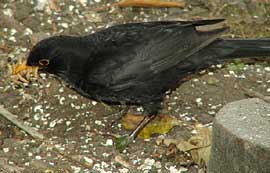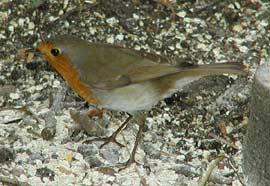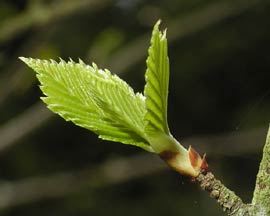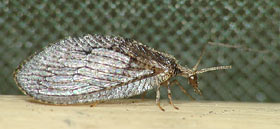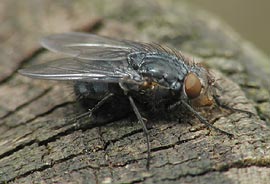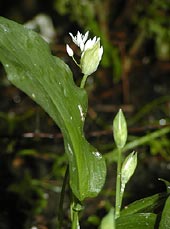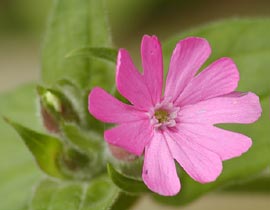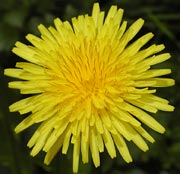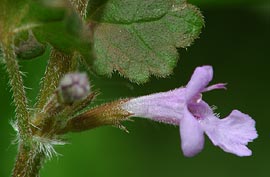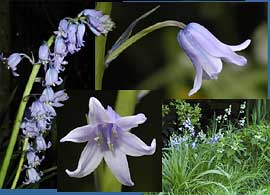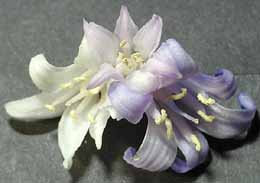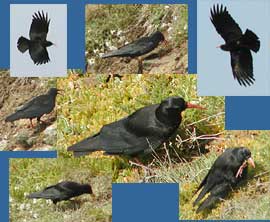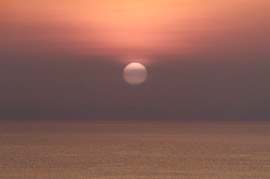Go to last entry of the month....................Go to previous entry14 April -
The female spent much of the day sitting on the nest with the male bringing food. The chicks are still very pink at this stage with the dark down hiding them some of the time.
Although she spent sometime sitting in the nest, the feamle spent more time away from it today.
This webcam image caught the female just after she had removed a faecal sac from the chick on the left. This usually happens just after the chick has been fed - the chick turns around and positions its rear end over the side of the nest cup.
As each day goes by it is useful to watch how the shape of the beak develops from thew wide gape of the young chick towards the much more characteristic pointed beak of the adult. It does not appear as though the female spent any time sitting on the nest during the day.
The second image shows the back of a chick, mostly bare but with a dark band of developing feathers from the neck to the area where the tail feathers will develop later.
Their heads and backs are covered with a stripy covering of feathers (top image) and they are starting to stretch their wings. The right hand image shows how well developed the flight feathers are.
I got back from Cornwall today and was greeted by an abandoned Blue Tit nest. Having seen confrontations between the BT's and the Robins before the holiday I have to wonder whether the parents of these chicks are responsible, being extra protective after the eggs had hatched.
A careful look at the Hawthorn revealed just one flower open today, and the tree is covered with buds so we can look forward to a good display as it lives up to its name as the May Tree. Its leaf cover is already almost complete.
A great deal of wing stretching and preening has gone on all through the days - with three such moments being captured in these webcam images.
Several times a chick was seen to wander from the nest cup. Here, one stands at the side to test its wings and then pauses for a short time before returning to be with its siblings.
During all the moving about we were able to catch glimpses of some details on the chicks. The left hand image shows how the breast feathers are already showing a reddish tinge, although it will be some time before the characteristic red breast develops. The top-right image gives a rare glimpse of a leg, and also the stubby growth that will become the robin's tail feathers.
Today feeding has taken on an urgency that has seen mealworms being brought in 'bundles' of three to five. The parent would continue to bring them in until no more beaks were presented for feeding. The lower image shows a faecal sac (from the right hand chick, facing away from the camera)being taken away - only the second time this was caught on camera.
The Robins have competion for any mealworms scattered in the garden as the Blackbirds have also got chicks to feed in their nest in the Ivy tree. I think the male has 12 in his beak!
All entries up to 26 April are being entered on the weekend of 26-27 April. I will be adding larger versions of each picture as soon as I can, and where possible I will add more notes.
27 April - The Robins have fledged.
At the end of the day I still have not seen any sign of the fledglings. The parents are taking food into the Ivy tree and the Leylandii, but the youngsters are well hidden .
On our returne from Cornwall, we noticed that on the higher branches of the Birch tree the leaves had started opening. Over the weekend a lot more of the buds on the lower branches have been bursting open and the tree is rapidly turning green.
A delicate visitor under a canopy by our house today was this Brown Lacewing - the wing pattern suggests that it is similar (I think) to Hemerobius humulinus.
Finally a humble house fly, or at least a member of that group of flies. This one was photographed on the log in the pond.
The miserably wet conditions outside made it impossible to scramble uner the Hawthorn to get a better picture so this was taken from a distance!
While in Cornwall, among the hegdgerows, dominated by the yellow of gorse and the white of flowering Blackthorn there were the occasional bursts of pink from the earliest Red Campion plants. Here in the garden things are a bit slower and so far most of the plants are far from flowering. However a couple of plants have flower buds and this is one of just two flowers open so far.
I have not forgotten about the Robins, but with it so wet it wasn't a day for spotting fledglings that would have been safely hidden away.
While it is only small, (about 17mm from base of flower stalk to tip of petal) the colour of this Ground-Ivy flower helps it to stand out in the sunshine.
The Bluebells are flowering in numerous parts of the garden. I am not certain whether they are native, Spanish Bluebells, or hybrids of the two types . When I look at sites that give comparative details of the two species, on most counts my lot seem to be natives, except that the leaves are, possibly, too wide.
Although most of the flowers are a sort of violet-blue, we also have some white and a few pink flowered plants, as shown here. They all have cream anthers. The filaments by which these are attached are all not joined to the petals at the same height. Both these features are characteristic of the native Bluebell.
There is a great deal of concern about the spread of the Spanish Bluebell at the expense of our Native flower. To find out more, visit the Wildlife Trust Species Action Plan page.
I have spent a bit of time today going through the small number of pictures taken during our trip to Cornwall, and I thought I'd share a few with you.
They are Choughs, a bird that forms part of the Cornish emblem and used to be so common there that they were know as Cornish Choughs. Absent from Cornwall for decades, they have started to return over the last couple of years. This was the first time I have ever seen them. The bright red beak and the wings with their splayed primary feathers really make the Chough stand out from the other members of the crow family.
The sky had been hazy all day, and as the sun dropped towards the sea it sank into the murk to create the most sci-fi sunset I have seen for a long time. |
|
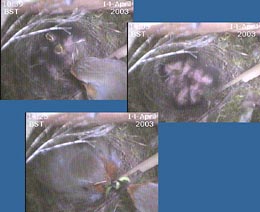
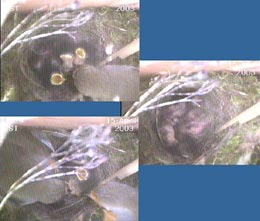 15
April - The small plant on the left started to become a problem
for the webcam today.
15
April - The small plant on the left started to become a problem
for the webcam today.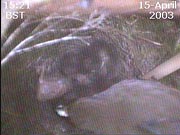
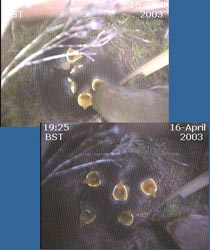 16
April - Lighting is
a problem for the webcam, with it not being able to cope with
drastic differences in light levels through the day. Along with
that, the plant continued to get in the way.
16
April - Lighting is
a problem for the webcam, with it not being able to cope with
drastic differences in light levels through the day. Along with
that, the plant continued to get in the way.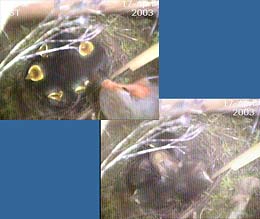 17
April - At this stage
the chicks often seem to arrange themselves around the sides
of the nest cup, as seen in the top image.
17
April - At this stage
the chicks often seem to arrange themselves around the sides
of the nest cup, as seen in the top image.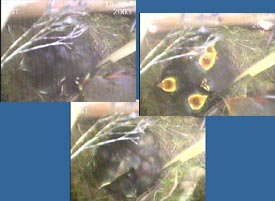 18
April - The bright
webcam images suggested that there was quite a bit of sunshine
today.
18
April - The bright
webcam images suggested that there was quite a bit of sunshine
today.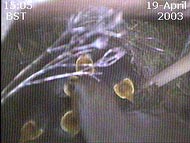 19
April - The wandering
plant was a nuisance for some of the day, but didn't stop the
webcam catching this image of the five chicks begging to be fed.
19
April - The wandering
plant was a nuisance for some of the day, but didn't stop the
webcam catching this image of the five chicks begging to be fed.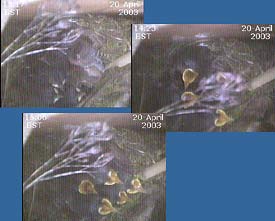 20
April - That plant again!
20
April - That plant again!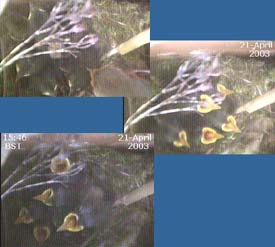 21
April - Feeding continued
with numerous webcam images showing the five gaping mouths below
that damned plant!
21
April - Feeding continued
with numerous webcam images showing the five gaping mouths below
that damned plant!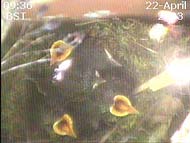 22
April - The adult Robins
must rub against the plant as they come and go, sometimes moving
it almost completely out of the picture.
22
April - The adult Robins
must rub against the plant as they come and go, sometimes moving
it almost completely out of the picture.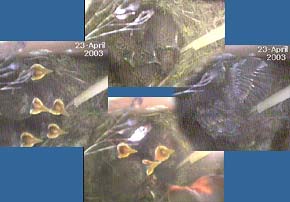 23
April - By today the
chicks are starting to show more clearly the markings of a young
Robin.
23
April - By today the
chicks are starting to show more clearly the markings of a young
Robin.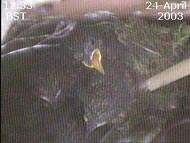 24
April - This image
shows the developing pattern on the head and back.
24
April - This image
shows the developing pattern on the head and back.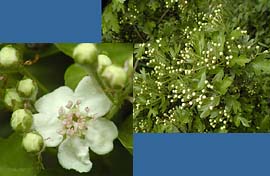 I
am in danger of neglecting the rest of the garden as I follow
the robins' progress, so an important event must be noted today.
I
am in danger of neglecting the rest of the garden as I follow
the robins' progress, so an important event must be noted today.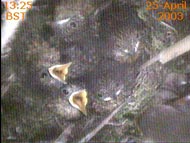 25
April - I have included this image of all five chicks looking
at a parent - notice how they still tend to arrange themselves
into a circle.
25
April - I have included this image of all five chicks looking
at a parent - notice how they still tend to arrange themselves
into a circle.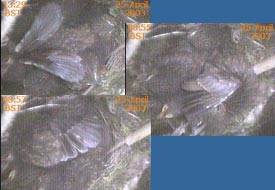
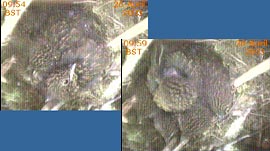 26
April - Preening has continued with increasing vigour today,
the striped markings showing up clearly in the morning sunshine.
26
April - Preening has continued with increasing vigour today,
the striped markings showing up clearly in the morning sunshine.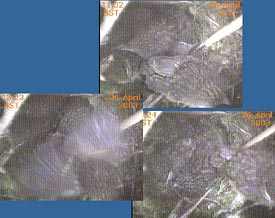
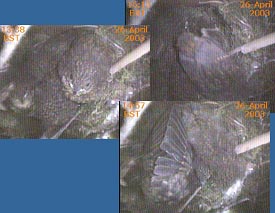
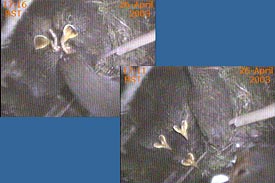 Up
to now, the adults have been bringing food as single items, even
when I have scattered mealworms for them.
Up
to now, the adults have been bringing food as single items, even
when I have scattered mealworms for them.